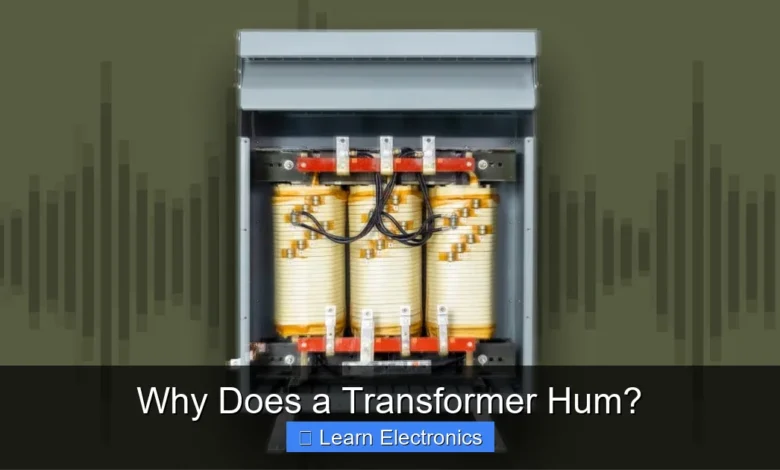Why Does a Transformer Hum?

Why Does a Transformer Hum? The characteristic humming sound from a transformer is primarily caused by a physical phenomenon known as magnetostriction within its core materials, coupled with mechanical vibrations from loose laminations. This ubiquitous noise is a natural byproduct of the alternating magnetic fields at work within these essential electrical devices.
Understanding this distinct sound helps in diagnosing potential issues and appreciating the physics behind power distribution. This article delves into the various reasons behind the transformer’s audible signature.
Quick Answers to Common Questions
Why Does a Transformer Hum?
The hum you hear from a transformer is typically caused by something called magnetostriction. This is when the magnetic core material slightly changes shape and vibrates rapidly due to the alternating magnetic field.
Is that humming sound normal for a transformer?
Absolutely! A gentle transformer hum is usually a completely normal byproduct of its operation. It simply means the electrical and magnetic forces within are doing their job.
Does a louder hum mean there’s a problem?
While a normal transformer hum is fine, a sudden increase in volume or a change in pitch can sometimes indicate an issue. If you notice your transformer humming unusually loud, it might be worth having it checked out by a professional.
📑 Table of Contents
The Core Cause: Magnetostriction
At the heart of a transformer’s operation, and indeed its hum, lies the principle of electromagnetism. However, it’s a specific material property interacting with the magnetic field that generates the primary sound we hear: magnetostriction.
What is Magnetostriction?
Magnetostriction is the property of ferromagnetic materials, such as the iron alloys used in transformer cores, to change their shape or dimensions when subjected to a magnetic field. When the magnetic field is applied, the magnetic domains within the material reorient themselves, causing a slight expansion or contraction. This effect is minuscule, typically on the order of a few parts per million, but it’s enough to generate sound.
How it Creates Sound
Transformer cores are energized by an alternating current (AC) at a specific frequency, typically 50 or 60 Hz, depending on the region. This AC creates a constantly changing magnetic field that reverses its direction multiple times per second. As the magnetic field fluctuates, the core material undergoes repeated cycles of expansion and contraction due to magnetostriction. Specifically, it expands and contracts twice for every complete cycle of the AC waveform. For a 60 Hz supply, this means the core is vibrating at 120 Hz, which is an audible frequency.
These rapid, microscopic deformations of the core material act like a tiny loudspeaker, pushing against the surrounding air and creating pressure waves that we perceive as sound. The intensity of this humming sound depends on the magnetic flux density, the volume of the core, and the magnetostrictive properties of the core material.
The Role of the AC Field
The alternating nature of the current is crucial for this process. A direct current (DC) would create a static magnetic field, causing a one-time change in dimension without continuous vibration. It’s the constant reversal and change in magnitude of the AC magnetic field that drives the continuous magnetostrictive deformation, producing the sustained hum. The specific frequency of the alternating current directly dictates the fundamental frequency of the humming sound, along with its harmonics.
Understanding Loose Laminations and Mechanical Vibration
While magnetostriction is the fundamental cause of the hum, mechanical vibrations, particularly those involving the laminated core, significantly contribute to the overall noise level and character.
The Assembly and Aging Process
Transformer cores are not solid blocks of metal; they are constructed from many thin sheets of ferromagnetic material, called laminations, stacked together and insulated from each other. This lamination process minimizes eddy currents, which would otherwise lead to significant energy loss and heating. These laminations are typically clamped or glued together to form a rigid core assembly.
Over time, and especially under continuous operation, these laminations can become slightly loose. Thermal cycling (heating up and cooling down), mechanical stresses from magnetic forces, and aging of insulating materials can weaken the clamping force or adhesive bonds. Once loose, these laminations are free to vibrate independently.
Resonance and Amplification
When the laminations become loose, they can vibrate at the same frequencies as the magnetostrictive forces (120 Hz for a 60 Hz supply, and its harmonics). This mechanical vibration is often much louder than the sound produced by magnetostriction alone because the larger surfaces of the laminations can move more air. If the natural resonant frequency of the loose laminations aligns with the magnetostrictive vibration frequency, the noise can be significantly amplified, resulting in a much more pronounced buzzing or humming sound.
This amplification can lead to noticeable differences in noise levels between transformers of similar design, simply due to variations in manufacturing tolerances or aging effects. The structural integrity of the core assembly plays a critical role in containing and dampening these vibrations, thus minimizing the audible output.
Electrical Factors Contributing to Noise
Beyond the inherent magnetostriction and mechanical looseness, various electrical conditions can exacerbate or alter the characteristic humming sound of a transformer.
Harmonic Distortion
In an ideal scenario, the voltage and current waveforms are pure sinusoids. However, in real-world power systems, especially with the proliferation of non-linear loads (like computers, LED lighting, and variable frequency drives), the current and voltage can become distorted. This distortion means the waveform contains frequencies that are integer multiples (harmonics) of the fundamental supply frequency (e.g., 3rd, 5th, 7th harmonics of 50/60 Hz).
These harmonic currents and voltages can excite additional magnetostrictive vibrations in the transformer core at their respective harmonic frequencies. For example, a 3rd harmonic in a 60 Hz system would cause vibrations at 180 Hz. The presence of these multiple frequencies can make the transformer’s hum sound harsher, more complex, or louder than expected, often characterized as a more pronounced buzzing rather than a smooth hum.
Overloading and Saturation
Transformers are designed to operate within specific current and voltage limits. If a transformer is overloaded, meaning it’s supplying more current than its design rating, the magnetic flux density in its core increases. Excessive current can push the core material into saturation, a state where further increases in magnetizing current produce little or no increase in magnetic flux. When a core operates in saturation, the magnetic field waveform becomes distorted.
This distorted magnetic field can lead to increased magnetostriction and significantly higher levels of harmonic generation, both of which amplify the audible noise. An overloaded or saturated transformer will not only hum louder but may also run hotter, indicating potential stress and reduced lifespan.
Poor Connections and Arcing
While less directly related to the steady humming, poor electrical connections within a transformer or its associated switchgear can generate buzzing or crackling sounds. Loose terminals, corroded contacts, or inadequate insulation can lead to localized arcing or partial discharges. These electrical phenomena produce distinct audible noises that are often irregular and sharper than the steady hum of magnetostriction. While not the primary cause of the hum, they are important to identify as they can indicate serious faults that require immediate attention.
External Influences and Environmental Factors
The perceived loudness and characteristics of a transformer’s hum aren’t solely determined by its internal mechanisms but also by its surroundings and operational environment.
Enclosure Design and Soundproofing
Many transformers, especially larger power transformers, are housed within enclosures. The design and materials of these enclosures play a significant role in how much of the internal noise propagates to the environment. Well-designed enclosures incorporate sound-absorbing materials and anti-vibration mounts to reduce the transmission of sound. Conversely, enclosures with hard, reflective surfaces can amplify and reflect sound, making the hum seem louder. Acoustic baffling and proper ventilation design are crucial for managing noise without impeding cooling.
Installation Location
The immediate environment where a transformer is installed also influences the perceived hum. A transformer placed in an open field will have its sound dissipate more readily than one installed in a confined space, like a substation building or an urban alley. Hard surfaces such as concrete walls, nearby buildings, or even rocky terrain can reflect sound waves, creating echoes and making the humming noise more pervasive. Careful consideration of the installation site, including proximity to residential areas and sound-reflecting structures, is vital for noise control.
Ambient Temperature
Ambient temperature can indirectly affect the transformer’s noise levels. Higher temperatures can lead to greater thermal expansion and contraction cycles, potentially loosening core laminations over time. Additionally, the viscosity of insulating oil (in oil-filled transformers) changes with temperature, which can slightly alter its dampening properties. While not a direct cause of the hum, extreme temperature variations or prolonged operation at high temperatures can contribute to material degradation and increased mechanical noise.
Common Noise Levels and Their Implications
The loudness of a transformer’s hum is typically measured in decibels (dB). Understanding typical noise levels helps distinguish between normal operation and potential problems.
Typical dB Levels
The noise level of a transformer varies significantly with its size, design, and load. Smaller distribution transformers might emit noise in the 40-50 dB range, which is comparable to a quiet conversation. Large power transformers in substations can produce noise in the 60-80 dB range, akin to typical office noise or heavy traffic at a distance. These levels are generally considered normal for their respective applications.
Here’s a simplified table illustrating typical noise levels:
| Transformer Type/Size | Typical Noise Level (dB) | Comparative Sound |
|---|---|---|
| Small Distribution (e.g., pole-mounted) | 40 – 50 dB | Quiet office, soft music |
| Medium Power (e.g., industrial) | 50 – 65 dB | Normal conversation, refrigerator hum |
| Large Power (e.g., substation) | 65 – 80 dB | Busy office, vacuum cleaner (at 10 ft) |
When to Be Concerned
While a transformer hum is normal, a sudden or significant change in its character or loudness can be a warning sign. Here’s what to look out for:
- Sudden Increase in Loudness: A noticeably louder hum might indicate overloading, core saturation, or rapidly loosening laminations.
- Change in Tone: A shift from a steady hum to a distinct buzz, rattle, or crackle often points to specific issues like harmonic distortion, loose mechanical parts, or electrical arcing.
- Intermittent Noises: Sounds that come and go, especially crackling or popping, can signal intermittent faults, partial discharges, or insulation breakdown.
- Accompanying Odors or Heat: If an unusually loud hum is accompanied by a burning smell or excessive heat, it’s a strong indicator of a serious problem requiring immediate professional inspection.
Any abnormal noise warrants investigation by qualified personnel to prevent potential equipment failure or safety hazards.
Mitigating Transformer Noise: Practical Solutions
Reducing transformer noise is an important consideration, especially in urban environments or noise-sensitive areas. Several strategies, from design to installation, can help manage the audible output.
Design and Manufacturing Techniques
- High-Quality Core Materials: Using advanced grain-oriented electrical steel with lower magnetostrictive properties can inherently reduce the amount of vibration generated in the core.
- Improved Core Clamping: Tighter and more robust clamping mechanisms for laminations, along with specialized adhesives or epoxy impregnation, help prevent laminations from becoming loose and vibrating independently over the transformer’s lifespan.
- Anti-Vibration Mounts: Internal and external anti-vibration mounts can isolate the core and coil assembly from the tank, preventing the tank itself from acting as a large sound radiator.
- Optimized Flux Density: Designing transformers to operate at lower magnetic flux densities, even if it requires a slightly larger core, can reduce the intensity of magnetostrictive forces.
Installation and Maintenance Practices
- Acoustic Barriers and Enclosures: Surrounding the transformer with sound-absorbing walls, barriers, or dedicated acoustic enclosures can significantly dampen noise propagation to the surroundings. These structures are designed to absorb or redirect sound waves.
- Strategic Placement: Positioning transformers away from noise-sensitive areas, such as residential buildings or hospitals, is a fundamental noise control strategy. Maximizing distance from receivers naturally reduces perceived sound levels.
- Regular Inspections: Periodic checks for loose hardware, degraded insulation, or signs of overheating can help address mechanical issues before they lead to increased noise. Tightening bolts and ensuring proper structural integrity are key maintenance tasks.
- Load Management: Ensuring transformers operate within their rated capacity and avoiding consistent overloading can prevent the increased noise associated with core saturation and harmonic distortion.
Advanced Noise Reduction Technologies
- Active Noise Cancellation: For very specific and challenging scenarios, active noise cancellation systems, which generate anti-phase sound waves to cancel out existing noise, can be employed, though these are complex and costly.
- Magnetic Shunts: In some designs, magnetic shunts can be strategically placed to divert portions of the magnetic flux, thereby reducing localized magnetostrictive effects and overall noise.
- Resin Encapsulation: Dry-type transformers often use resin encapsulation for the coil and core assembly. This robust encapsulation not only provides insulation but also effectively dampens mechanical vibrations, reducing noise.
The combined application of these techniques can significantly reduce the audible impact of transformers, making them more environmentally friendly in terms of noise pollution.
In conclusion, the characteristic hum emanating from a transformer is a normal and expected phenomenon, primarily rooted in the fascinating principle of magnetostriction and further influenced by the mechanical integrity of its laminated core. While typically harmless and a sign of active operation, understanding the nuances of this sound is crucial. A steady, low-level hum indicates healthy functioning, but a sudden increase in loudness, a change in tone to a buzz or rattle, or accompanying unusual smells or heat are definitive indicators of potential underlying issues that warrant professional assessment. By appreciating the science behind this electrical whisper, we gain insight into the reliable workhorse that powers our modern world and learn when its voice might be signaling a need for attention.
Frequently Asked Questions
Why does a transformer hum?
The primary cause of a transformer’s hum is a phenomenon called magnetostriction. This occurs when the magnetic core material slightly changes shape and dimension in response to the alternating magnetic field, causing microscopic vibrations that generate sound waves.
What frequency is a transformer hum?
The characteristic hum you hear from a transformer typically corresponds to twice the line frequency, meaning 100 Hz or 120 Hz, depending on whether it’s a 50 Hz or 60 Hz power system. This is because the magnetic core expands and contracts twice per AC cycle as the magnetic field changes polarity, creating audible vibrations.
Is it normal for a transformer to hum?
Yes, a slight humming sound is completely normal for operating transformers and does not typically indicate a problem. It’s a natural consequence of the magnetostriction effect within the core as it processes electrical energy. However, a sudden change in hum volume or a very loud hum could signal an issue.
What can make a transformer hum louder?
Several factors can increase the loudness of a transformer’s hum, including increased electrical load, which intensifies the magnetic forces. Loose core laminations, faults in the winding, or mechanical issues can also amplify the vibrations and the resulting noise output. High voltage fluctuations can also contribute to a louder hum.



